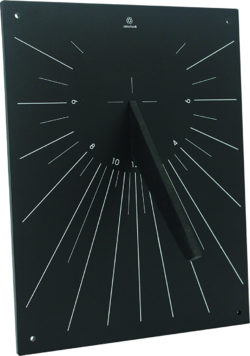Vertical Sundial Designer: Difference between revisions
From DT Online
mNo edit summary |
mNo edit summary |
||
| Line 11: | Line 11: | ||
Ideally, the 'dial' of a '''Vertical Sundial''' should be fixed to a South-facing wall or surface. In this situation the '''[[Sundials and Gnomons|Gnomon]]''' is located in a plane at right angles to the 'dial' and will cast a vertical shadow at Noon. If placed on a wall which is not South-facing ''(e.g. S.E. or S.W.)'' then the '''[[Sundials and Gnomons|Gnomon]]''' will need to be angled to the 'dial' such that the shadow cast at Noon remains vertical and is said to be [http://en.wikipedia.org/wiki/Declination '''Declined'''] East or West as appropriate. | Ideally, the 'dial' of a '''Vertical Sundial''' should be fixed to a South-facing wall or surface. In this situation the '''[[Sundials and Gnomons|Gnomon]]''' is located in a plane at right angles to the 'dial' and will cast a vertical shadow at Noon. If placed on a wall which is not South-facing ''(e.g. S.E. or S.W.)'' then the '''[[Sundials and Gnomons|Gnomon]]''' will need to be angled to the 'dial' such that the shadow cast at Noon remains vertical and is said to be [http://en.wikipedia.org/wiki/Declination '''Declined'''] East or West as appropriate. | ||
---- | |||
<span style="color: green">'''Note:''' | |||
For walls at some variance from being south facing, the hour lines would need to angled differently on each side of the dial. This is well explained on the British Sundial Society website - see [http://sundialsoc.org.uk/old/HDSW.php 'How do sundials work?' Part 18. '''Introduction to decliners'''] | |||
</span> | |||
---- | |||
{{Packaging Designer Guide}} | {{Packaging Designer Guide}} | ||
Latest revision as of 11:04, 11 September 2018
Description
As with a Horizontal Sundial the Gnomon of a Vertical Sundial remains pointing North and set at an angle to the horizontal equal to the Latitude of the Sundial location. The Gnomon therefore must be set at an angle to the 'dial' of 900. minus Latitude.
Features and Applications
Ideally, the 'dial' of a Vertical Sundial should be fixed to a South-facing wall or surface. In this situation the Gnomon is located in a plane at right angles to the 'dial' and will cast a vertical shadow at Noon. If placed on a wall which is not South-facing (e.g. S.E. or S.W.) then the Gnomon will need to be angled to the 'dial' such that the shadow cast at Noon remains vertical and is said to be Declined East or West as appropriate.
Note: For walls at some variance from being south facing, the hour lines would need to angled differently on each side of the dial. This is well explained on the British Sundial Society website - see 'How do sundials work?' Part 18. Introduction to decliners
Designer
- Click on the pencil-shaped Edit icon below to show or hide variables and click inside table to alter values (scroll to see all).
- Left or Right click on the screen display or use Scroll Wheel to alter view and Left click on Zoom icon to restore (note: Zoom will be focussed around the cursor position)
- Left click on Download icon and Open with your preferred browser then print screen image from there (useful for trying ideas for text and graphics etc. but unlikely to be actual size), or Save File to create a full-size Scalable Vector Graphics (svg) file which can be loaded into LibreOffice Draw and printed, or graphics software such as Inkscape for eventual output at actual size to a Plotter/Cutter for example. See Packaging Designer User Guide for more detail.
Note:
- In the table below, enter the Latitude of where your Sundial will be located.
- Since the main purpose of this Sundial Designer is to establish the correct angles for the Hour LInes, a simple screen Print-out will often be sufficient to transfer these on to your actual 'Dial Plate'.
- Alternatively, the table also provides the number of degrees for each Hour Line away from the Noon position and can be marked out directly on to your 'Dial Plate' material.
 |
 |
 |
 |
 |
 |
| Brass Sundial |
Large Round Slate Garden Sundial |
Vertical Garden Sun Clock |
Brass Armillary Sphere Sundial |
Cast Iron Armillary Sundial |
Sundial Compass |



